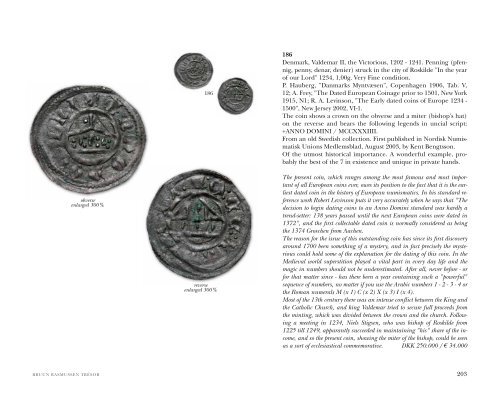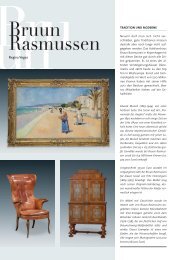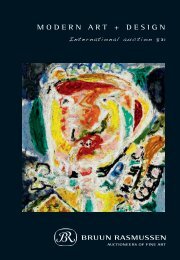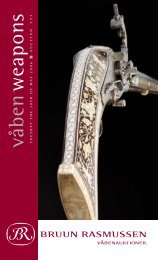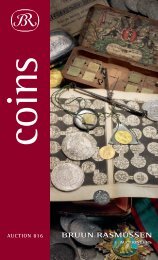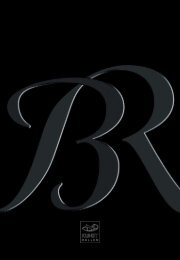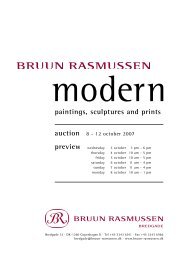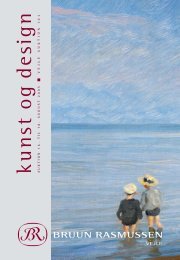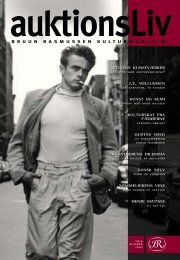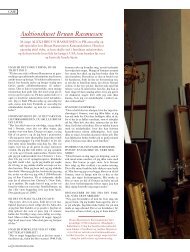Sell what you have plenty of Buy now - Bruun Rasmussen
Sell what you have plenty of Buy now - Bruun Rasmussen
Sell what you have plenty of Buy now - Bruun Rasmussen
Create successful ePaper yourself
Turn your PDF publications into a flip-book with our unique Google optimized e-Paper software.
obverse<br />
enlarged 300%<br />
BRUUN RASMUSSEN TRÉSOR<br />
186<br />
reverse<br />
enlarged 300%<br />
186<br />
Denmark, Valdemar II, the Victorious, 1202 - 1241. Penning (pfennig,<br />
penny, denar, denier) struck in the city <strong>of</strong> Roskilde "In the year<br />
<strong>of</strong> our Lord" 1234, 1,00g. Very Fine condition.<br />
P. Hauberg, "Danmarks Myntvæsen", Copenhagen 1906, Tab. V,<br />
12; A. Frey, "The Dated European Coinage prior to 1501, New York<br />
1915, N1; R. A. Levinson, "The Early dated coins <strong>of</strong> Europe 1234 -<br />
1500", New Jersey 2002, VI-1.<br />
The coin shows a crown on the obverse and a miter (bishop's hat)<br />
on the reverse and bears the following legends in uncial script:<br />
+ANNO DOMINI / MCCXXXIIII.<br />
From an old Swedish collection. First published in Nordisk Numismatisk<br />
Unions Medlemsblad, August 2003, by Kent Bengtsson.<br />
Of the utmost historical importance. A wonderful example, probably<br />
the best <strong>of</strong> the 7 in existence and unique in private hands.<br />
The present coin, which ranges among the most famous and most important<br />
<strong>of</strong> all European coins ever, owes its position to the fact that it is the earliest<br />
dated coin in the history <strong>of</strong> European numismatics. In his standard reference<br />
work Robert Levinson puts it very accurately when he says that "The<br />
decision to begin dating coins to an Anno Domini standard was hardly a<br />
trend-setter: 138 years passed until the next European coins were dated in<br />
1372", and the first collectable dated coin is normally considered as being<br />
the 1374 Groschen from Aachen.<br />
The reason for the issue <strong>of</strong> this outstanding coin has since its first discovery<br />
around 1700 been something <strong>of</strong> a mystery, and in fact precisely the mysterious<br />
could hold some <strong>of</strong> the explanation for the dating <strong>of</strong> this coin. In the<br />
Medieval world superstition played a vital part in every day life and the<br />
magic in numbers should not be underestimated. After all, never before - or<br />
for that matter since - has there been a year containing such a "powerful"<br />
sequence <strong>of</strong> numbers, no matter if <strong>you</strong> use the Arabic numbers 1 - 2 - 3 - 4 or<br />
the Roman numerals M (x 1) C (x 2) X (x 3) I (x 4).<br />
Most <strong>of</strong> the 13th century there was an intense conflict between the King and<br />
the Catholic Church, and king Valdemar tried to secure full proceeds from<br />
the minting, which was divided between the crown and the church. Following<br />
a meeting in 1234, Niels Stigsen, who was bishop <strong>of</strong> Roskilde from<br />
1225 till 1249, apparantly succeeded in maintaining "his" share <strong>of</strong> the income,<br />
and so the present coin, showing the miter <strong>of</strong> the bishop, could be seen<br />
as a sort <strong>of</strong> ecclesiastical commemorative. DKK 250.000 / € 34.000<br />
203


